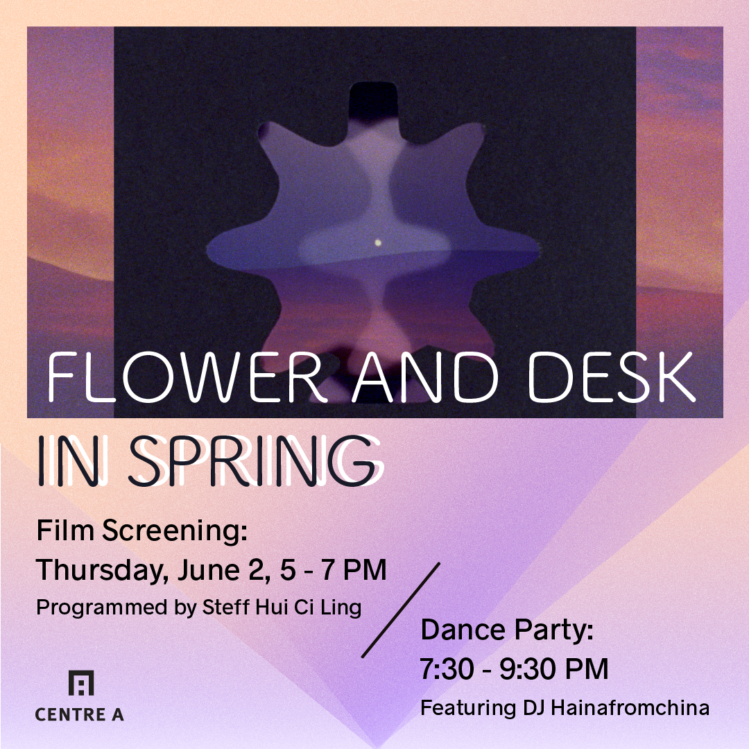
FLOWER AND DESK IN SPRING Film Screening
Thursday, June 2, 2022, 5 – 7 PM PDT
–
Centre A presents the screening of FLOWER AND DESK IN SPRING, a collection of videos with simple and elegant approaches to educational filmmaking and videography featuring a variety of flowers, geometry, and the use of classical, experimental, and anime opening music.
–
Programmed by Steff Hui Ci Ling
“When I started putting the program together, I thought about the times when I worked at a gallery and sat behind a desk while listening to the muffled audio of a video work looping in the black box yonder. I wanted to assemble a program that would be pleasant to listen to if it could be heard from the office throughout the workday, or if the sound happened to bleed through the walls to the neighbouring business inside Keefer Mall. The total screening time is 76-minutes on loop, but since visitors may not be able to view it from the beginning, my other goal for the program was to put together something that would maintain geometric or organic forms on screen throughout, so there would always be an inviting or curious shape or colour (or sound) to greet the visitor.”
Steff Hui Ci Ling is an occasional producer of criticism, pamphlets, stories, essays, exhibitions, reviews, bluntness, anecdotes, shout-outs, wrestling storylines, proposals, applications, jokes, readings, minimal poems, poems, dinner, compliments, and diatribes. She is a student, cultural worker and guest living on the unceded territories of the Musqueam, Squamish, Tsleil-Waututh First Nations. Currently, she is an MA Candidate in the Department of Sociology and Anthropology at Simon Fraser University and working as a teaching assistant in Labour Studies. For fun, she designs and co-edits STILLS: moving image tract and organizes a Marxish Study Group. Her books are NASCAR (Blank Cheque, 2016), CUTS OF THIN MEAT (Spare Room, 2015), and MIXED MARTIAL ARTS (House House Press, forthcoming).
–
Program:
Bruce and Katharine Cornwell, Trio for Three Angles (1968), 8 minutes
Barry Doupé, Thalé (2009), 5 minutes
Bruce and Katharine Cornwell, Journey to the Center of a Triangle (1976), 9 minutes
Lily Jue Sheng and Rita Ferrando, Ikebana (2022), 13 minutes
Bruce and Katharine Cornwell, Congruent Triangles (1976), 7 minutes
EnergizedClippy, Attack on Angles Anime The Final Season OP – My Congruent Angle War (2020), 2 minutes
Barry Doupé and Yota Kobayashi, Shikisou (with visuals) (2012), 12 minutes
EnergizedClippy, Congruent Angles Anime OP – A Cruel Angle’s Thesis (2016), 2 minutes
Bruce and Katharine Cornwell, Similar Triangles (1975), 8 minutes
Bruce and Katharine Cornwell, Dragon Fold (1978), 8 minutes
EnergizedClippy, No Math No Life Anime OP – This Angle (2022), 2 minutes
Bruce and Katharine Cornwell, Trio for Three Angles (1968), 8 minutes
Bruce Cornwell became interested in math films after he saw Disney’s Donald in Mathmagic Land (1959) and thought he could make a better film. Most of Bruce and Katharine Cornwell’s work is now out of distribution, however, much of it is now accessible online to watch and download through YouTube, the Internet Archive and their son Eric’s Vimeo channel, who released some of his parents work under Creative Commons in 2014. The Cornwells made three sequels to Trio, which was the last hand-animated film before switching over to making most of their films on a Tektronix 4051 Graphic Computing System. The subsequent computer-generated triangle trilogy, Congruent Triangles, Similar Triangles and Journey to the Center of a Triangle, is included in this program too.
Barry Doupé, Thalé (2009), 5 minutes
Doupé’s computer animation Thalé is named after the thale cress, arabidopsis thaliana, mouse-ear cress, or arabidopsis, which is a small flowering plant native to Eurasia and Africa. The title flora is a popular model organism in plant biology to understand the molecular biology of plant traits including flower development and light sensing. That is one pedagogical flower! The rotating fictional flowers in the animation incorporate geometric forms inspired by sex toys and Doupé’s most excellent imagination.
Bruce and Katharine Cornwell, Journey to the Center of a Triangle (1976), 9 minutes
Journey to the Center of a Triangle was made on the Tektronix 4051 which only produced black and green vector images, so a creative and elaborate process of layering multiple exposures and optical printing took place during the programming to achieve a variety of coloured dots necessary to be visually distinct and beautifully instructive in the final scene, “The Grand Tour.” Much of that vibrance was lost in the translation from 16mm to VHS scanning, and now viewed on a modern computer screen, it has an even more limited colour gamut. Their son Eric Cornwell asks us to “Please imagine it all in bright, brilliant colours.”
Lily Jue Sheng and Rita Ferrando, Ikebana (2022), 13 minutes
The process of putting the program together actually began with Lily Jue Sheng and Rita Ferrando’s Ikebana. In this film, there are lines read from one of four source texts, instructional or informative books about ikebana (the Japanese art of flower arranging), ”Ikebana presents three main branches,” oh, like a triangle, I thought, “the past, the present and the future.”
Ikebana shares a similar occupation with the films in the Cornwell’s Trio for Triangles while offering its own combination of animation, music, with documentary verité of an ikebana showcase to bring a lightness and action to the educational material.
Bruce and Katharine Cornwell, Congruent Triangles (1976), 7 minutes
Congruent Triangles makes a number of cameos in the program, but a complete viewing brings together the full triangle lesson, while performing an echoing and evolving form expressed in Yota Kobayashi and Barry Doupé’s concept of Shikisou. To a score described as “Bach meets Third Stream Jazz musical score” the congruent triangles ripple out like a Busby Berkley ensemble to produce a hemp-like pattern on the screen in the film’s final act.
EnergizedClippy, Attack on Angles Anime The Final Season OP – My Congruent Angle War (2020), 2 minutes
While I was researching the different versions of Journey posted online, I came across EnergizedClippy’s video in the related videos’ column on YouTube. Attack on Angles Anime The Final Season OP – My Congruent Angle War is a parody of the opening theme song for the final season of Attack on Titan (2013–present). The creator combined footage from Cornwells’ Journey to the Center of a Triangle and Congruent Triangles with the opening song for the very popular anime, My War. As described under the video’s page, “Math tutorials are still the best anime, and is even more hype with the final season!”
The titles of EnergizedClippy’s math tutorial x anime OP (the acronym used to refer to opening credit or opening music) videos combine the titles of Cornwell’s triangle films and the paired song. There are three in total dating from 2016 to 2022, which are all included in this program, as well. These videos reminded me of the interesting ways that people procrastinate when they are studying difficult subjects. These songs lend a melodrama to the otherwise serene triangle films, like a humorous missive from a night of cramming before a big math test.
The program’s title, FLOWER AND DESK IN SPRING, follows in EnergizedClippy’s rhetorical fun and is a hybrid between some of the subject matter of the program — flowers, the seasons, studying math (most likely at a desk) — and the poetic name of a popular Yunnan-style restaurant in the West End, Flower and Horse in Spring, where Henry and I ate once. I think it was over this meal when he asked me to submit an idea for The Living Room.
Barry Doupé and Yota Kobayashi, Shikisou (with visuals) (2012), 12 minutes
The Japanese word “shikisou” means a cyclical gradation of colors (“hue”) as well as “appearance” or “visible figure”. In addition to these definitions metamorphosis is a key concept within Shikisou. There are an infinite number of rhythms in the universe. Some are familiar and comprehensible, others, incognito. Each rhythm echoes from the ones before it, “in a continuous evolution of polyrhythmic and cyclical patterns that are the temporal foundation of the universal symphony.” Shikisou refers to a cycle of seasons to measure time, but expresses the symbolism and emotional assignment that seasons often extend by portraying approaching figurative “sound events” associated with memories of each season. Even though it adheres to a profound principle, something determinative and grandiose like a genesis of rhythm and its resultant patterns, and there is tension between cyclical and non-cyclical layers of sound, the pulsing orb seems to contain and express something less threatening than disorder and more poetic than a scientific axiom.
Shikisou brings to mind the colourful dots in the final scene in Trios, the ones that indicate, but also decorate, the lessons of the triangle. As well, the way the shapes in the Cornwells’ films seem to move and morph as if they tirelessly rehearsed the choreography before committing these movements to the animation process in a similar way to the pulsing orb protagonist of Shikisou. Shikisou also makes use of a form to represent time (the metric of the four seasons), which reminded me of the three main branches of an ikebana arrangement representing the past, present and future.
EnergizedClippy, Congruent Angles Anime OP – A Cruel Angle’s Thesis (2016), 2 minutes
After I discovered Attack on Angles, I wondered if this was some sort of internet trend, however EnergizedClippy seems to be the progenitor and sole producer of the hybrid anime OP x educational films, of which there are three. The first video was 2016’s Congruent Angles Anime OP – A Cruel Angles Thesis. It uses a combination of footage from Journey and Congruent Angles with A Cruel Angel’s Thesis (1995) from Neon Genesis Evangelion. There are lots of joyful and thankful remarks in the comments but the one pinned at the top is pretty good: “Get in the math class, Shinji.” Meanwhile, in the YouTube comments for the Cornwells’ Congruent Triangles, a user states that this is their favourite episode of Evangelion.
Bruce and Katharine Cornwell, Similar Triangles (1975), 8 minutes
Similar Triangles is the first in the Cornwells’ triangle trilogy. In this lesson, we are taught about triangles sharing corresponding angles and proportional sides.To a soothing folk guitar number, this lesson provides an entrancing demonstration of contracting and expanding concentric patterning and pyramidic configurations
Bruce and Katharine Cornwell, Dragon Fold (1978), 8 minutes
The extended title of this film, Dragon Fold and Other Ways to Fill Space is an upbeat visual cabaret of demonstrations in how infinite line segments, infinite closed curves, or a single closed curve multiply to gradually create denser and denser space filling patterns on the screen. Featuring the Sierpinski curve and the eponymous dragon curve.
EnergizedClippy, No Math No Life Anime OP – This Angle (2022), 2 minutes
The popularity of 2016’s Congruent Angles had a second surge of popularity in 2022. As a token of gratitude to their viewers for the 1-million views, the now relatively inactive account posted No Math No Life Anime OP – This Angle. As with the earlier videos, No Math No Life uses footage from the Cornwells’ Journey, Congruent Triangles, in addition to Dragon Fold, and introduces some contemporary source material including videos on linear algebra and fourier series by commensurately serene 3Blue1Brown, a sincerely helpful math edutainment YouTuber. The background music, This Game, was the opening credits for the 2014 anime, No Game, No Life, which was not renewed for a second season because of a controversy about plagiarism. This is EnergizedClippy’s first edit made entirely with Adobe Premiere CC 2018, instead of Vegas Pro.
IMPORTANT NOTES REGARDING YOUR VISIT:
- Face masks or face coverings are encouraged when not drinking or eating. We also encourage you to sanitize your hands before and after visiting. Masks and hand sanitizer are available for you as needed.
- Due to Sun Wah Centre’s security measures, please locate the security guard posted at the front gate to be let into the building. Otherwise, please call Centre A at (604) 683-8326 during the event hours.
Accessibility: The gallery is wheelchair and walker accessible. If you have specific accessibility needs, please contact us at (604) 683-8326 or [email protected].
Centre A is situated on the unceded territories of the Musqueam, Squamish, and Tsleil-Waututh peoples. We honour, respect, and give thanks to our hosts.









